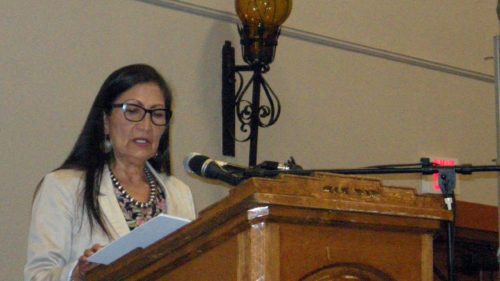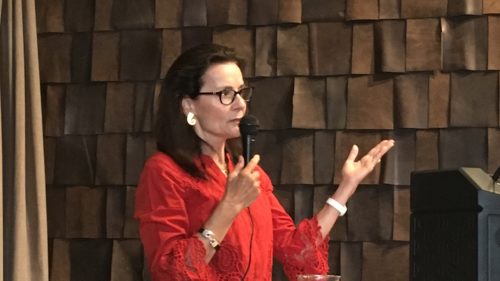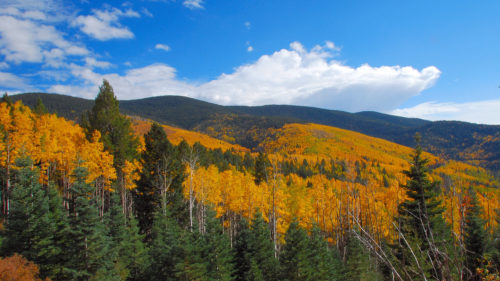By BEN NEARY
NMWF Conservation Director
ALBUQUERQUE — At its first meeting Friday, the newly empaneled New Mexico Game Commission unanimously elected two women members to leadership positions.
The commission also gave provisional approval to transferring ownership of a lake in Rio Arriba County to a community land grant.
The commission unanimously elected Joanna Prukop to serve as chairwoman. Then it unanimously elected Roberta Salazar-Henry as vice-chairwoman.
Both Prukop and Salazar-Henry previously had long careers as administrators in the New Mexico Department of Game and Fish.
“I kind of hate to point out the obvious, but I think we just made history,” Prukop said after the votes. Previously, the leadership posts on the commission have been held by men.
Salazar-Henry, of Las Cruces, had a 25-year career with the game department. She represents southern New Mexico — an area she said has vast public lands and active conservation groups and great outfitters.
“I look forward to working with all of you on coming to consensus on some issues that have been hanging around for a while,” Salazar-Henry said.
Gov. Michelle Lujan-Grisham, a Democrat, announced the appointment of Prukop, Salazar-Henry and other five new game commissioners in May. The state had been without a game commission since the governor in April requested the resignations of commissioners appointed by former Republican Gov. Susana Martinez.
Prukop, of Santa Fe, previously served as the secretary of the state Energy, Minerals and Natural Resources Department. Before that, she worked for over 25 years at the game department. After leaving state government, she served in President Barack Obama’s administration as a three-term appointee to the Wildlife and Hunting Heritage Conservation Council.
In her opening remarks, Prukop emphasized that the purpose of the game commission is to set policy for the game department. She said it’s the department director’s job to oversee the department’s daily operations. She said no individual commissioner has authority to direct the director or the staff.
“We’re here to steer the agency toward a sustainable future,” Prukop said.
Prukop said she wants to see the commission devise a policy manual. “We intend to be a transparent, clear, inclusive commission.”
Prukop said she encouraged individuals or groups to write to the commission with comments or concerns. She and other commissioners said they want to schedule future meetings in locations and at times that will invite the most public involvement. Friday’s meeting was streamed live on the internet.
Commissioner Jeremy Vesbach was among the commissioners who said he supports drafting a policy manual for the commission. “I hope that with this commission, we can set a new level of transparency and participation,” he said.
Working through its first agenda, the commission voted to transfer the Mesilla Valley Bosque State Park back to the State Parks Division.
The Legislature this year directed the game department to return the 13-acre park to the Parks Division. The division had transferred it recently to the game department for use as a regional headquarters location because of low park visitation.
The commission voted conditionally to approve the transfer of the Laguna del Campo, also known as Burns Lake, to the Tierra Amarilla Land Grant. The Legislature this year voted to allow the commission to make the transfer at its discretion.
Prukop said the commission will schedule final action on the transfer at its meeting this August in Santa Fe. By then, she said she expects the game department will have met with land grant officials as well as officials of the La Puente Ditch to iron out liability issues and the specifics of the transfer.
Jim Comins, assistant game department director, told the commission that a review by the New Mexico State Engineer’s’ Office had found that the dam at the lake has an insufficient spillway. In a huge rain event, he said water could run over the dam and cause it to fail, posing a risk to anyone downstream.
Options for addressing the situation ranged from breaching the dam to modifying the spillway, to the tune of millions of dollars, Comins said. If the commission turned the lake over to the land grant, he said it would be the land grant’s responsibility to stock it with fish and maintain it.
However, Comins said the game commission had entered into an agreement with the La Puente Ditch in the 1930s that placed some obligations on the department that will need to be considered.
Steve Polaco, president of the Tierra Amarilla Grant, told the commission that the land grant wants the lake back.
“We have been in the struggle for regaining our common lands, community and culture for 175 years,” Polaco said, adding that getting the lake would be a first step.
In response to a question from Prukop, Polaco said the Tierra Amarilla Grant wants to pursue acquisition of other game commission lands in the area: the Humphries, Sargent and Rio Chama wildlife areas.
Prukop said that obviously raised concerns with the commission.
At a meeting of the Legislature’s Land Grant Committee, held last July in Abiquiu, Melvin Apodaca, a board member of the Tierra Amarilla Land Grant, requested the return of “traditional use rights” on the Sargent, Humphries and Rio Chama wildlife areas.
According to the minutes of the committee meeting, Apodaca, “elaborated on Tierra Amarilla’s view that grazing, water and hunting rights in the wildlife areas should belong to Tierra Amarilla and he asserted that economic problems for communities throughout northern New Mexico began when the land grants lost their common lands.”
State Sen. Richard Martinez, D-Espanola, told the game commission Friday that he believed that Polaco had misspoken when he said there are other parcels of game commission lands aside from the lake that the Tierra Amarilla Land Grant wants to go after.
“All they want is the right of first refusal,” Martinez said, adding they want to get lands back that had been illegally taken from them.
Rep. Miguel Garcia, an Albuquerque Democrat and chairman of the House Land Grant Committee, told the commission there was precedent for the game commission to return lands to land grants. He said the commission had returned more than 30 acres to the Abiquiu Land Grant about 10 years ago.
Garcia said the common lands in the Tierra Amarilla Land Grant were stolen from the land grant heirs by “The worst, most corrupt landowner in the history of the world, Thomas B. Catron.”
Catron, leader of a group of land speculators known as the “Santa Fe Ring,” held various positions in New Mexico’s territorial government and served as U.S. Senator after statehood. At one point, he owned millions of acres of land in the state, much of it former land grant lands. He died in 1921.
Six commissioners voted in favor of approving the transfer to the land grant provisionally, with the understanding that they will vote again in August. Commissioner David Soules of Las Cruces, appointed to serve at-large to represent conservation interests on the commission, abstained.



